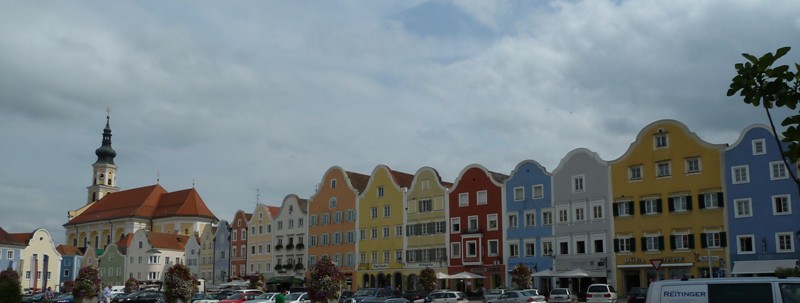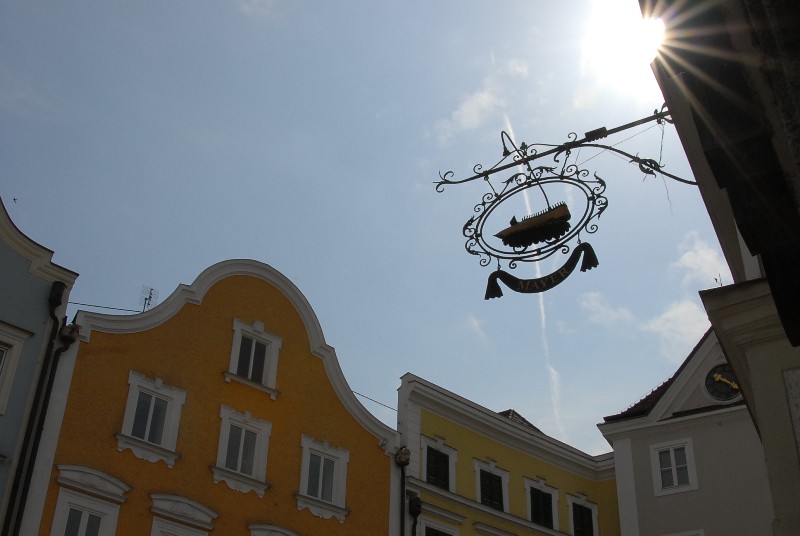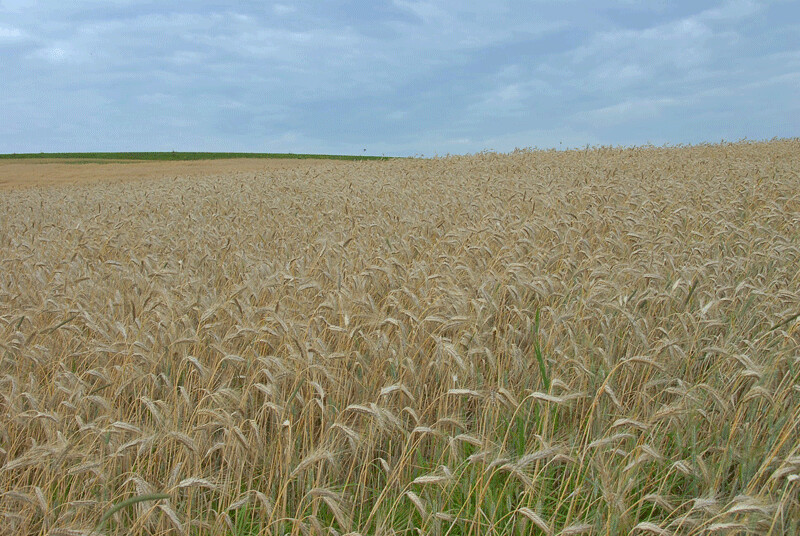
The cookie was a Linzer Auge. I was eating it with a tiny pastry fork at the Linzer Bakery on the main plaza in Schaerding. A Linzer Auge is a sandwich cookie, two crenellated pieces of shortbread filled with red current jam. This was quite a good one, the shortbread was buttery and crumbly, the jam just a little bit tart. I also had a cappuccino to wash it down, with no whipped cream, thank you.
On the building from whence said Linzer Auge appeared there was a little sign that said that the bakery was once the home to a historic gingerbread maker. The place also produced mead and candles. It was all about the honey in 1405, apparently.
I looked at the sign for a while. “Luxury items,” I said to my sister in law, R. “And all having something to do with bees!” she added, insightfully.
We’d ended up in Schaerding, (the husband J, sister in law R, and myself) because, for the third time the navigation software on J’s new phone had sent us somewhere we could not go. This time, the map wanted us to drive up a road that was closed.
The previous time, in Salzburg, the navigation sent us into a pedestrian zone, underneath some funicular tracks, through a castle gate, and after all that, it informed us that we were, at our destination. We walked for another 15 minutes down the narrow, steep path to the market plaza below. We’d left the car parked at the blue “Pedestrians Only” sign and didn’t try to force it over Salzburg castle’s historic stone walkways.
This time, when faced with the “road closed” sign, we turned off the navigation and referred to the atlas. It made sense to go to Schaerding, so we did. And when the signs said “Schaerding, Beautiful Baroque City” we stopped to have a look. Schaerding is indeed pretty and baroque, with brightly painted houses facing into the main square. Some of them have beautiful stucco embellishments; many of them have little flip hairdo roof lines.

In addition to her baroque finery, the city has some medieval architecture, the gates – including the Linz Tower, right next to the Linzer Bakery – the stone fortress walls, a fresco or three, and some high water markers from the Middle Ages. The city sits on the banks of the Inn river – it’s now the border between Germany and Austria.

Schaerding has about a dozen shoe stores in the heart of the city, two of them had wrought iron signs that featured shoes sculpted shoes. If you were unable to read, you still could figure out that yep, this was the place to get your footwear needs addressed. If that wasn’t enough, each merchant guild had an assigned color. Bakeries were blue.
At the Linzer Bakery, I tried to imagine a history for Schaerding. Clearly, it was a well to do village in the baroque times, the houses were big and had lots of windows. The gingerbread bakery/mead cellar/candle maker was much older, but I suppose things weren’t so bad in Schaerding in the 1400s either – after all, if the town could support a business offering such treats, the resident’s basic needs must have been met. The prevalence of shoe stores made me wonder if they hadn’t also had a thriving leather trade.

The area around Schaerding is abundant farmland. It’s not quite Austria’s bread basket, that’s further northeast, but the rolling hills were covered with grain crops – oats, rye, spelt. The farmhouses were big three and four floor blocks with gated courtyards and often, dairy barns. The land smelled of grass and cows, and at one point, the air was thick with the heavy scent of honey.
I wasn’t far off with my imagined history for the city. Schaerding was a trade center for all kinds of goods, with an emphasis on textiles, from as early as the 900s. The city brochure says that Schaerding shuffled back and forth between Austria and a then independent Bavaria for many years — both sides wanted the city. There were wars and fires and floods, and the plague, and at the end of World War II, the city was bombed by American forces. Now it’s touristy on a small scale, there are a handful of boutique hotels in the city center and a public art project which replicates the seven wonders of the ancient world.
The center of town was lively on a weekday morning. The cafes were busy, there were two tour groups taking a walking tour. Parking wasn’t difficult but the lot was far from empty. Many of the old houses were beautifully renovated. We walked in to a courtyard that sold garden sculptures, more luxury items. Ivy climbed the fortress walls, little flower boxes bolted to the lookout tower held neon colored petunias. The city was immaculate.
By the end of the day, I’d pieced together more about Schaerding. The city brochure and walking guide (happily bilingual, in German and English) opens with a brief essay about Schaerding’s prosperity. There are brief descriptions and historical facts about significant buildings and towers within the old city.
The guide does not include the 1405 bakery where I ate my Linzer Auge. J, ever the indulgent travel companion, asked the waitress for more information about her 600 year old place of employment. “Sorry, I’ve got nothing.” she replied.

That Google maps! Keeps bringing you to the wrong place. I suspect it’s controlled by the Wicked Witch of the West. “Pamela, and her ukelele and her precious J! I’ve got them now!”You stick to the Yellow Brick Road girl, and you go!